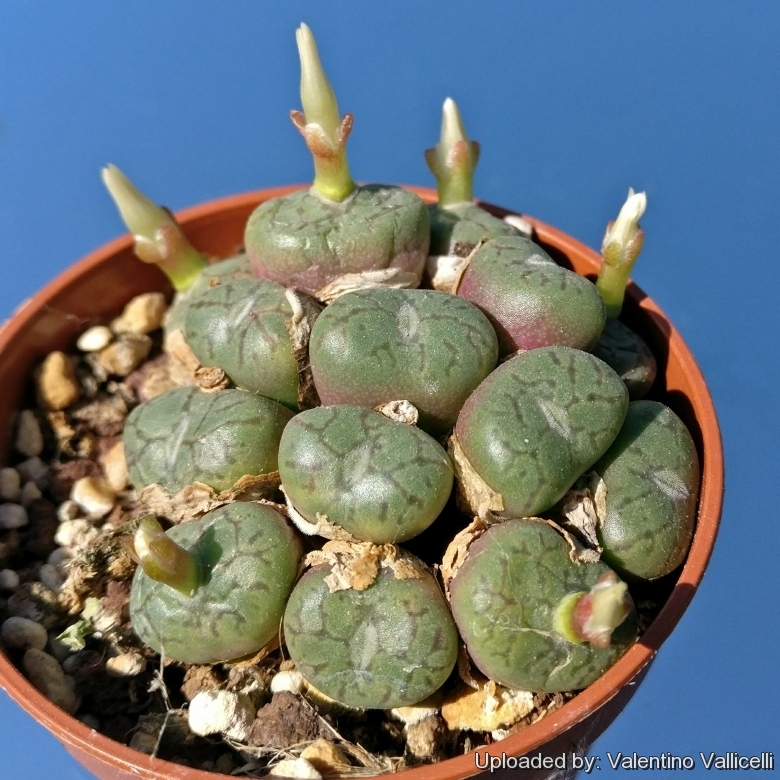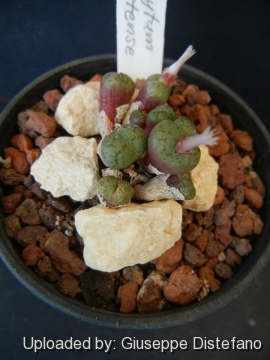




Your support is critical to our success.
Accepted Scientific Name: Conophytum obcordellum (Haw.) N.E.Br.
Gard. Chron. 1922, Ser. III. lxxi. 307.

Origin and Habitat: Lambert Bay, Western Cape province of South Africa.
Synonyms:
- Conophytum lambertense Schick & Tischer
Conophytum obcordellum (Haw.) N.E.Br.
Gard. Chron. 1922, Ser. III. lxxi. 307.
Synonymy: 34
- Conophytum obcordellum (Haw.) N.E.Br.
- Conophytum creperum N.E.Br.
- Conophytum giftbergense Tischer
- Conophytum klaverense N.E.Br.
- Conophytum lambertense Schick & Tischer
- Conophytum lambertense var. conspicuum Rawé
- Conophytum longifissum Tischer
- Conophytum nevillei (N.E.Br.) N.E.Br.
- Mesembryanthemum nevillei N.E.Br.
- Conophytum obconellum (Haw.) Schwantes
- Conophytum obcordellum f. declinatum (Haw.) N.E.Br.
- Conophytum declinatum L. Bolus
- Conophytum obcordellum var. germanum (N.E.Br.) Rawé
- Conophytum germanum N.E.Br.
- Conophytum obcordellum f. multicolor (Tischer) Tischer
- Conophytum multicolor Tischer
- Conophytum obcordellum var. mundum (N.E.Br.) Rawé
- Conophytum mundum N.E.Br.
- Conophytum obcordellum var. parvipetalum (N.E.Br.) Tischer
- Conophytum parvipetalum (N.E.Br.) N.E.Br.
- Mesembryanthemum parvipetalum N.E.Br.
- Conophytum obcordellum f. picturatum (N.E.Br.) Tischer
- Conophytum obcordellum var. mundum f. picturatum (N.E.Br.) Rawé
- Conophytum picturatum N.E.Br.
- Conophytum obcordellum f. stayneri (L. Bolus) Rawé
- Conophytum obcordellum var. mundum f. stayneri (N.E.Br.) Rawé
- Conophytum ursprungianum var. stayneri L. Bolus
- Conophytum parviflorum N.E.Br.
- Conophytum parviflorum var. impressum (Tischer) Tischer
- Conophytum impressum Tischer
- Conophytum spectabile Lavis
- Conophytum ursprungianum Tischer
Conophytum obcordellum var. ceresianum (L. Bolus) S.A.Hammer
Gen. Conophytum 235. 1993
Synonymy: 4
- Conophytum obcordellum var. ceresianum (L. Bolus) S.A.Hammer
- Conophytum ceresianum L. Bolus
- Conophytum ceresianum var. divergens (L. Bolus) Rawé
- Conophytum divergens L. Bolus
Conophytum obcordellum subs. rolfii (de Boer) S.A.Hammer
Gen. Conophytum 260. 1993
Synonymy: 3
- Conophytum obcordellum subs. rolfii (de Boer) S.A.Hammer
- Conophytum lambertense var. rolfii (de Boer) Rawé
- Conophytum rolfii de Boer
Conophytum obcordellum subs. stenandrum (L. Bolus) S.A.Hammer
Gen. Conophytum 263. 1993
Synonymy: 2
- Conophytum obcordellum subs. stenandrum (L. Bolus) S.A.Hammer
- Conophytum stenandrum L. Bolus
ENGLISH: Lambert's Bay Conophytum
RUSSIAN (Русский): Конофитум обратносердцевидный
Description: Conophytum lambertenseSN|16149]]SN|16165]] is a small coastal form of the widespread and morphologically variable Conophytum obcordellumSN|16165]]SN|16149]] subsp. obcordellum coming from Lambert Bay (hence the name), however the two plants are not readily distinguishable, if not for the geographical provenance. This dwarf succulent species has tiny pancake-shaped bodies marked with few to many dots and lines, these often raised and glossy. It is extremely decorative even without flowers.
Habit: It is variably caespitose, with single or double bodies, or forming dense mats or cushions.
Bodies (paired leaves): Small, pancake-shaped, convex or concave at the apex, about 1 (or less) cm in diameter with a small growing cleft that doesn't reach right across the body.
Colours: Silvery-green, variously spotted light or dark brown. The unspotted sides are pink to a deep dark red, while the apex, which is glabrous, medium green, and variably suffused with reddish or dark green dots that are slightly raised, which sometimes join up to make lines and which turn a beautiful bright red during the resting period.
Flowers: Often paired, large with a white, yellow or rich pink-creamy colour with a pale yellow centre. The thin petals form an almost star-like, spidery structure, they are aromatic and very showy.
Blooming season: Blooms mostly in autumn (in cultivation in Europe August-November). The flowers are numerous and open at night.
Fruits: 4-6 locular hygrochastic capsules.
Subspecies, varieties, forms and cultivars of plants belonging to the Conophytum obcordellum group
 Conophytum giftbergense Tischer: has larger bodies with smaller, not merging less lively coloured dots.
Conophytum giftbergense Tischer: has larger bodies with smaller, not merging less lively coloured dots. Conophytum lambertense Schick & Tischer: is a small coastal form. Distribution: Lambert Bay, Western Cape province of South Africa.
Conophytum lambertense Schick & Tischer: is a small coastal form. Distribution: Lambert Bay, Western Cape province of South Africa. Conophytum obcordellum (Haw.) N.E.Br.: (subsp. obcordellum) it is very variable with markings or raised spots; Flowers nocturnal strongly scented. Distribution: Northern Cap and Western Cape
Conophytum obcordellum (Haw.) N.E.Br.: (subsp. obcordellum) it is very variable with markings or raised spots; Flowers nocturnal strongly scented. Distribution: Northern Cap and Western Cape Conophytum obcordellum var. ceresianum (L. Bolus) S.A.Hammer: has very finely splattered markings and forms a dense mat. Flowers cream colored often with pink staminodes.
Conophytum obcordellum var. ceresianum (L. Bolus) S.A.Hammer: has very finely splattered markings and forms a dense mat. Flowers cream colored often with pink staminodes. Conophytum obcordellum f. multicolor (Tischer) Tischer: has grey-green almost metallic colouring, and the sides and the markings on the top of the body are dark purple: Distribution: Van Rhynsdorp district, Cape Province, South Africa.
Conophytum obcordellum f. multicolor (Tischer) Tischer: has grey-green almost metallic colouring, and the sides and the markings on the top of the body are dark purple: Distribution: Van Rhynsdorp district, Cape Province, South Africa.- Conophytum obcordellum subs. rolfii (de Boer) S.A.Hammer: Leaves very small greysh-green to reddish with coarse fine lines and reddish papillae (The most heavily papillate member of the group) Distribution: Vredendal, Western Cape.
 Conophytum obcordellum subs. stenandrum (L. Bolus) S.A.Hammer: Few branched distinctively metallic greysh-green with fine lines and dots not extending down the sides. Distribution: Western Cape (Vanrhynsdorp) and Northern Cape (Namaqualand)
Conophytum obcordellum subs. stenandrum (L. Bolus) S.A.Hammer: Few branched distinctively metallic greysh-green with fine lines and dots not extending down the sides. Distribution: Western Cape (Vanrhynsdorp) and Northern Cape (Namaqualand) Conophytum spectabile Lavis: has small bodies with exquisite markings.
Conophytum spectabile Lavis: has small bodies with exquisite markings.
Bibliography: Major references and further lectures
1) Gordon D. Rowley “The illustrated encyclopedia of succulents” Crown Publishers, 01/Aug/1978
2) James Cullen, Sabina G. Knees, H. Suzanne Cubey “The European Garden Flora Flowering Plants: A Manual for the Identification of Plants Cultivated in Europe, Both Out-of-Doors” Cambridge University Press, 11/Aug./2011
3) Raimondo, D., von Staden, L., Foden, W., Victor, J.E., Helme, N.A., Turner, R.C., Kamundi, D.A. and Manyama, P.A. 2009. “Red List of South African Plants.” Strelitzia 25. South African National Biodiversity Institute, Pretoria.
4) Hammer, S. 1993. “The Genus Conophytum - A Conograph.” Succulent Plant Publications, Pretoria.
5) Hammer, S. 2002. “Dumpling and His Wife: New Views of the Genus Conophytum.” East Anglia Engraving Creative Colour Ltd, Norwich, England.
6) Ernst Van Jaarsveld, Ben-Erik Van Wyk, Gideon Smith “Succulents of South Africa: A Guide to the Regional Diversity” Tafelberg Publishers, Limited, 01/lug/2000
7) Heidrun E.K. Hartmann “Illustrated Handbook of Succulent Plants: Aizoaceae A-E” Springer, 2002
8) Werner Rauh “The Wonderful World of Succulents: Cultivation and Description of Selected Succulent Plants Other Than Cacti” Smithsonian Institution Press, 1984
9) Hermann Jacobsen “Lexicon of Succulent Plants” Littlehampton Book Services Ltd. 1974

Conophytum lambertense Photo by: Giuseppe Distefano
The gallery now contains thousands of pictures, however it is possible to do even more. We are, of course, seeking photos of species not yet shown in the gallery but not only that, we are also looking for better pictures than those already present. Read More...
Cultivation and Propagation: Conophytum lambertenseSN|16165]]SN|16165]] is easy to grow. These plants grow on winter rain and head for summer dormancy. More or less dormant in summer. The plant requires little water; otherwise its epidermis breaks (resulting in unsightly scars). Water throughout the year although minimally in summer, (only when the plant starts shrivelling), but it will generally grow even in summer if given water. Water regularly in winter after the previous year's leaves have dried up. Requires good drainage. Keep cool and shaded from hot sun in mid-summer; it needs full sun or light shade in the other seasons. Hardy to -2°C. Ensure a very good ventilation. Avoid to repot frequently. This plant may stay in the same pot for many years. Plants grown in larger containers have frequently relatively poor flowers. It might improve when the plants are given their own, small individual pots.
Propagation: It can be reproduced both by cuttings and seeds. Take the cutting from a grown-up mother plant. Each cutting must contain one or more heads, along with a fraction of root.
| Your Actions | |
|---|---|
| Back to Conophytum index | |
| Back to Aizoaceae index | |
 |
Back to Succulents Encyclopedia index |
Privacy stantement - Terms and conditions - How to cite - About us - Feedback - Donate



